1 review for Raktpipasa
You must be logged in to post a review.

Aa Pustak Alag Alag Laghukatha Ma Vahechayali Chhe. Jema Anrejo Na Jamani Ni Kathao Nu Varnan Karvama Aavyu Chhe.
Sir Henry Rider Haggard, (22 June 1856 – 14 May 1925), known as H. Rider Haggard, was an English writer of adventure novels set in exotic locations, predominantly Africa, and a pioneer of the Lost World literary genre. He was also involved in agricultural reform throughout the British Empire. His stories, situated at the lighter end of Victorian literature, continue to be popular and influential. After returning to England in 1882, Haggard published a book on the political situation in South Africa, as well as a handful of unsuccessful novels, before writing the book for which he is most famous, King Solomon’s Mines. He accepted a 10% royalty rather than £100 for the copyright.
A sequel soon followed entitled Allan Quatermain, followed by She and its sequel Ayesha, swashbuckling adventure novels set in the context of the Scramble for Africa (although the action of Ayesha happens in Tibet). The hugely popular King Solomon’s Mines is sometimes considered the first of the Lost World genre. She is generally considered to be one of the classics of imaginative literature. and with 83 million copies sold by 1965, it is one of the best-selling books of all time. He is also remembered for Nada the Lily (a tale of adventure among the Zulus) and the epic Viking romance, Eric Brighteyes.
His novels portray many of the stereotypes associated with colonialism, yet they are unusual for the degree of sympathy with which the native populations are portrayed. Africans often play heroic roles in the novels, although the protagonists are typically European (though not invariably). Notable examples are the heroic Zulu warrior Umslopogaas and Ignosi, the rightful king of Kukuanaland, in King Solomon’s Mines. Having developed an intense mutual friendship with the three Englishmen who help him regain his throne, he accepts their advice and abolishes witch-hunts and arbitrary capital punishment.
Three of Haggard’s novels were written in collaboration with his friend Andrew Lang who shared his interest in the spiritual realm and paranormal phenomena.
Haggard also wrote about agricultural and social reform, in part inspired by his experiences in Africa, but also based on what he saw in Europe. At the end of his life, he was a staunch opponent of Bolshevism, a position that he shared with his friend Rudyard Kipling. The two had bonded upon Kipling’s arrival at London in 1889 largely on the strength of their shared opinions, and the two remained lifelong friends.





Skryf Review
Amazing Read.Raktpipasais an historical novel by English writer H. Rider Haggard, published in 1892. It is said to be inspired by Haggard’s time in South Africa (1875–1882). It was illustrated by Charles H. M. Kerr.Raktpipasa is set at the time of Chaka, the Zulu king, around whom much of the action turns, but essentially the book is the story of Umslopogaas, and of “his love for Nada, the most beautiful of Zulu women.” They have been brought up as brother and sister but Umslopogaas is really Chaka’s son. It is narrated by Mopo the father of Nada and witch doctor to Chaka, whom Chaka had vowed never to slay because he saved the life of Chaka and his mother when they were outcast wanderers.During the course of the novel Umslopogaas teams up with Galazi the Wolf, who lives on Ghost Mountain and has power over a spectral wolf pack. The story ends tragically when Nada, fleeing the wrath of Dingaan following the assassination of Chaka, takes refuge in a cave on the mountain. Galazi dies in her defence but the cave proves her tomb as she is unable to open the stone door she closed behind her.